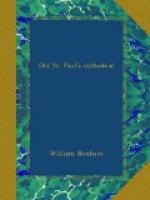Concerning the dramatic performances which went on in the cathedral at certain times, there is nothing peculiar to St. Paul’s that I know of to mention. These performances were originally intended for instruction, pictorial representations of scenes from the Bible and Church History, but often degenerating into coarse buffoonery and horseplay. The “Boy Bishop” was for many generations an established institution. One ceremony there was, peculiar to St. Paul’s, namely, “The Offering of a Buck and Doe.” Sir William le Baud in 1328 made a yearly grant to the Dean and Canons of a doe to be presented on the Feast of the Conversion of St. Paul, and of a fat buck to be offered at the midsummer commemoration of the same Apostle.
These were to be offered at the high altar by Sir William and his descendants, and afterwards to be distributed among the Canons resident. This gift was in acknowledgment of a grant which they had made him of twenty-two acres of land adjoining his park in Essex. There was a grand ceremonial on each occasion, the Canons wore their best vestments and garlands of flowers, and there was a procession round the church, with the horns of the buck carried on a spear, and a great noise of horn-blowers. Camden describes it all, as an eye-witness. This festivity came to an end in the reign of Queen Elizabeth.
[Illustration: BISHOP AND CANONS IN THE CHURCH OF ST. GREGORY-BY-ST. PAUL. From a MS. of Lydgate’s Life of St. Edmund. British Museum, Harl. 2278.]
Our illustration, showing the costume of the clergy of St. Paul’s, is taken from a MS. of Lydgate’s Life of St. Edmund, written in the fifteenth century, and decorated with many miniatures. It represents the coffin of St. Edmund temporarily deposited in the church of St. Gregory-by-St. Paul’s (having been brought up from Bury for safety during an incursion of the Danes), and an attempt by the Bishop and Canons to secure so precious a relic for the cathedral. Here is Lydgate’s metrical version of the story, telling how the attempt was frustrated by the Saint himself.
He cam to Londene toward eve late,
At whos komyng blynde men kauhte syht.
And whan he was entred Crepylgate
They that were lame be grace they goon
upryht,
Thouhtful peeple were maad glad and lyht;
And ther a woman contrauct al hir lyve,
Crying for helpe, was maad hool as blyve.




